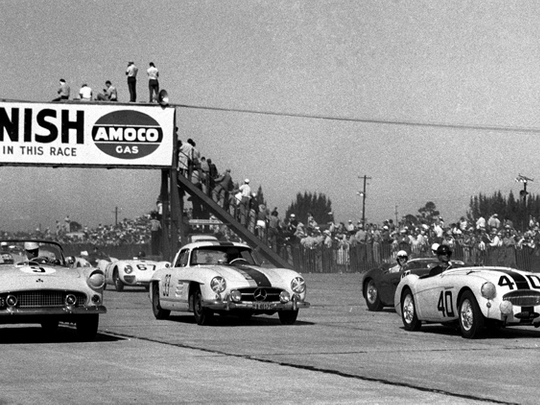
When Vic Sharp began his journey from his Tampa home on New Year's Eve in 1950 to an airfield in central Florida that had just been converted to a racetrack, little did he know that he was driving his 724cc Crosley Hot Shot roadster to racing history. At that inaugural six-hour endurance race in Sebring, he got way more than he expected. He lent his car to race drivers Fritz Koster and Bob Deshon, who stripped it down and raced it to victory, and that against a line-up that included Astons, Ferraris and Jaguars. Of course, the scoring system that took into account more than just flat-out speed helped, but this sense of unpredictability surely added to the track's eventual rise to glory.
Long before the first race, in 1941, Sebring began life as a flight training base for the US Air Force, with B-17 bombers laying rubber on its wide concrete runways. But after the Second World War, the facility usually lay disused and it caught the attention of Russian-born aeronautical engineer Alec Ulmann.
An avid racing enthusiast, Ulmann had always dreamt of staging an endurance race event on the lines of the 24 Hours of Le Mans this side of the Atlantic. He converted a major portion of the airstrip to a racetrack, keeping the rough concrete pavements as such.
On March 15, 1952, the first 12 Hours of Sebring was held at the track, which was a roaring success and attracted legendary names such as Juan Manuel Fangio, Jacky Ickx, Stirling Moss, Dan Gurney and Geoff Brabham over the years as well as all major constructors from Jaguar, Ferrari and Porsche to Audi, Nissan and Peugeot. And it's been the setting for many an epic battle too, the most notable being the classic 12-hour duel between Mario Andretti's Ferrari and the Porsche driven by actor Steve McQueen and Peter Revson.
Although it was these ‘once around the clock' races that cemented Sebring's position as one of the world's best-known circuits, the track has many other firsts to its credits. In 1959, it played host to the first Formula 1 Grand Prix in the USA. The very first Trans Am race was held here as a support race ahead of the 1966 12-hour event. The rough concrete surface of the track with its prominent seams is capable of breaking both man and machine, with sparks literally flying at every corner.
It's known to be one of the toughest tests for engines, transmissions, brakes, chassis and the men behind the wheel. No wonder then that most drivers and constructors consider the12 hours of Sebring the best possible preparation for Le Mans.
The track, which was originally 8.4km long, underwent many changes over the decades and is now shortened to 5.9km, out of which 4.8km is asphalt and the rest is still concrete. These changes were made mostly to improve safety by separating the active runways from the circuit as today the airport facility and the racetrack exist side by side. The 1.43km stretch — the longest straight on the historic track — that led to a right-angled turn, is now an exclusive airstrip.
It's not just fast cars that attract motorsport fans to Sebring, it's also the festival atmosphere they get there. The track allows camping within its premises days before the races start where even trailers are allowed to be parked.











